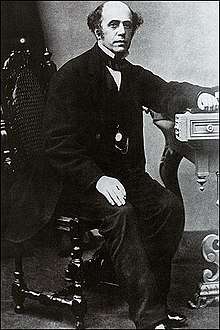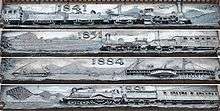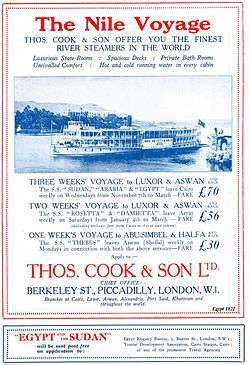Thomas Cook
| Thomas Cook | |
|---|---|
 | |
| Born |
23 November 1808 Melbourne, Derbyshire, England, UK |
| Died |
18 July 1892 (aged 83) Knighton, Leicester, England |
| Nationality | British |
| Occupation | Founder of Thomas Cook & Son |
| Organization | Thomas Cook & Son |
Thomas Cook (22 November 1808 – 18 July 1892) was an English businessman. He is best known for founding the travel agency Thomas Cook & Son.
Life
Thomas Cook was born to John and Elizabeth Cook, who lived at 9 Quick Close in the village of Melbourne, Derbyshire.[1]
The couple's first child, he was named after Elizabeth's father, Thomas Perkins, a New Connexion Baptist pastor. John Cook died when Thomas was three years old, and his mother remarried later that same year.
At the age of 10, Cook started working as an assistant to a local market gardener for a wage of six pence a week. At the age of 14, he secured an apprenticeship with his uncle John Pegg, and spent five years as a cabinet maker.[1]
He was brought up as a strict Baptist. In February 1826, Cook became a Baptist missionary, and toured the region as a village evangelist, distributing pamphlets and occasionally working as a cabinet maker to earn money.[1]
In 1832, Cook moved to Adam and Eve Street in Market Harborough. Influenced by the local Baptist minister Francis Beardsall, he took the temperance pledge on New Year's Day in 1833. As a part of the temperance movement, he organised meetings and held anti-liquor processions.[1]
.jpg)
On 2 March 1833, Cook married Marianne Mason (1807–1884) at Barrowden in Rutland. A son, John Mason Cook, was born on 13 January 1834.[1] Thomas Cook died at Thorncroft, Knighton, Leicester, on 18 July 1892, having been afflicted with blindness in his declining years.[2] He was buried with his wife and daughter at Welford Road Cemetery, Leicester.
Cook's first excursions

Cook's idea to offer excursions came to him while "walking from Market Harborough to Leicester to attend a meeting of the Temperance Society".[3] With the opening of the extended Midland Counties Railway, he arranged to take a group of temperance campaigners from Leicester Campbell Street railway station to a teetotal rally in Loughborough, eleven miles away. On 5 July 1841, Thomas Cook escorted around 500 people, who paid one shilling each for the return train journey, on his first excursion. During the following three summers he planned and conducted outings for local temperance societies and Sunday school children.

On 4 August 1845 he arranged for a party to travel from Leicester to Liverpool. In 1846, he took 350 people from Leicester on a tour of Scotland. In 1851 he arranged for 150,000 people to travel to the Great Exhibition in London. Four years later, he planned his first excursion abroad, when he took two groups on a 'grand circular tour' of Belgium, Germany and France, ending in Paris for the Exhibition. During the 1860s he took parties to Switzerland, Italy, Egypt and the United States.
The Thomas Cook statue outside Leicester Railway Station, London Road, Leicester (pictured above) was unveiled on 14th January 1994 by his great-great-grandson Thomas Cook. It was sculpted by James Walter Butler RA.
Thomas Cook & Son

In 1872, he formed a partnership with his son, John Mason Cook, and renamed the travel agency as Thomas Cook & Son.[2] They acquired business premises on Fleet Street, London. The office also contained a shop which sold essential travel accessories, including guide books, luggage, telescopes and footwear. Thomas saw his venture as both religious and social service; his son provided the commercial expertise that allowed the company to expand.
In accordance with his beliefs, he and his wife also ran a small temperance hotel above the office. Their business model was refined by the introduction of the 'hotel coupon' in 1868. Detachable coupons in a counterfoil book were issued to the traveller. These were valid for either a restaurant meal or an overnight hotel stay provided they were on Cook's list.
Conflicts of interest between father and son were resolved when the son persuaded his father, Thomas Cook, to retire at the end of 1878. He moved back to Leicester and lived quietly until his death.
The firm's growth was consolidated by John Mason Cook and his three sons, especially by its involvement with military transport and postal services for Britain and Egypt during the 1880s, when Cook began organising tours to the Middle East.
By 1888, the company had established offices around the world, including three in Australia and one in Auckland, New Zealand and in 1890, the company sold over 3¼ million tickets.[4]
John Mason Cook promoted, and even led, excursions to, for example, the Middle East where he was described as "the second-greatest man in Egypt".[4] However, while arranging for the German Emperor Wilhelm II to visit Palestine in 1898, he contracted dysentery and died the following year.
Thomas Cook and Mass Tourism
Thomas Cook was a frontrunner of establishing tourism systems and thus made Mass Tourism possible in Italy. First, the circular tickets could be used on almost all Italian railways. These tickets allowed travel by train for a preset number of days along predetermined routes. Second, Cook designed a series of hotel coupons to complement circular tickets, which could be exchanged for lodging and meals at designated accommodations. Last, he introduced the circular notes which could be changed at designated hotels, banks, and tickets agents for Italian lire at a predetermined exchange rate. Cook's introduction of tourism-specific currency facilitated easier and effective trips within Italy. Also, by introducing a widely dispersed coupon system, Cook "helped to stabilize the burgeoning Italian economy not only by increasing the revenues from tourism but also by expanding the circulation of Italy's new currency, the lira." The coupon system spread rapidly and were well accepted throughout Italian cities. Furthermore, thanks to this system, middle class Italians could afford to travel more frequently and more easily.[5]
Cook had an ultimate goal to put tourism in the service of unifying the Italian state before Italian unification. He became more aware of Italian politics and became particularly concerned with the fate of the newly unified Italian state. He pondered how tourism could ameliorate the economic and political difficulties. He believed that tourism could reinforce the unification of Italy by physical travel from one place to another, connecting different regions of Italy.
In 1880, the Italian government joined Cook's tour company. The Italian economy benefited from additional tourism profits in which Cook programmed and executed as a system. Cook certainly played a key role in not only boosting the Italian economy but also bringing atmosphere and morale of Italian unification. Italians physically felt their country from place to place by traveling.
See also
References
- 1 2 3 4 5 Williamson, Andrew. The Golden Age of Travel. Thomas Cook. ISBN 978-1-900341-33-2.
- 1 2 Chisholm 1911.
- ↑ Ingle R, 'Thomas Cook of Leicester'
- 1 2 Anthony Coleman (1999). Millennium. Transworld Publishers. pp. 231–233. ISBN 0-593-04478-9.
- ↑ Stephanie Malia Hom (2015). Destination Nation: The Grand Tour, Thomas Cook, and the Arrival of Mass Tourism. University of Toronto Press. pp. 93–103. ISBN 1-442-64872-4.
- Attribution


External links
| Wikimedia Commons has media related to Thomas Cook. |